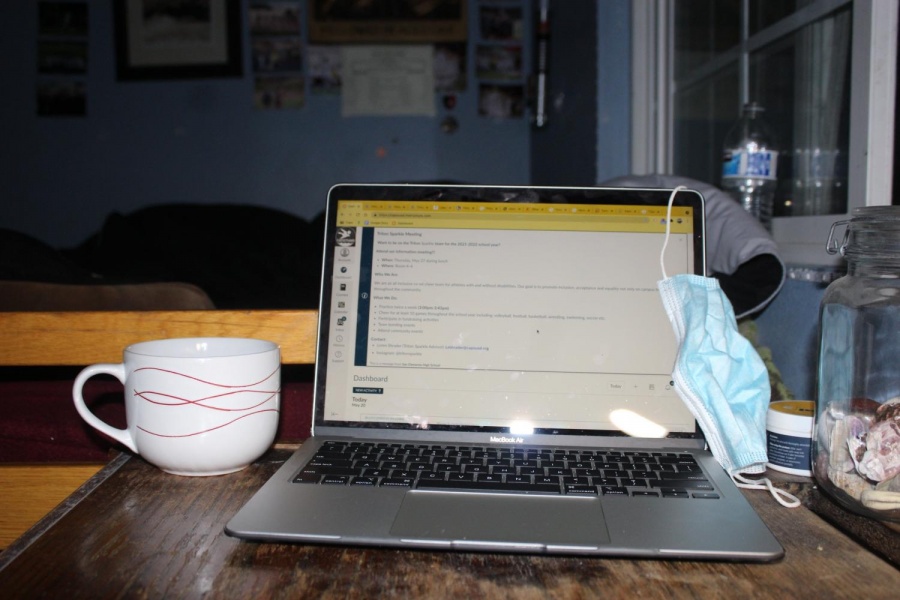
Amy Parr | Head Editor
May 20, 2021
This school year has been like no other. We started out 100% online, five days a week for the first few months, but eventually students got the option to go back in person two days a week, and just a few weeks ago, hybrid students started going in person four days a week. Both weekly and daily bell schedules changed a couple of times, which was consistent with the general unpredictability of the school year. Nobody knew what to expect when the school year began, and now that it’s finally ending, students are able to reflect on their experiences with this whirlwind of a year.
“Online learning was a nice break from reality and it was a good time to reset, but I’m really excited to go back in the fall,” junior Madeline McDonald said. “I realized over the course of the year that you just can’t replicate in person learning, and I’m super excited and grateful to be returning to regular school soon.”
Virtual classes were a new concept for most students, since the end of the previous school year primarily consisted of independent work and zero face to face interactions with teachers. Many students expected this tradition of self-paced learning to continue into the 2020-21 school year, and were taken aback by the mandatory daily Zoom meetings. Fortunately, this generation of students is unusually technologically capable, but issues are inevitable when the entire concept of education relies on technology.
“During a presentation, my internet connection dropped while I was talking which made me super anxious,” McDonald said. “I feel like online learning introduced a bunch of new stressors since I never had to worry about that kind of thing during regular school.”
Technological issues were not the only consequence of online learning. Students had to be on Zooms for up to seven hours a day, which can get overwhelming, especially since most homework assignments were online as well.
“Before I switched to the hybrid model, I was constantly staring at a screen,” junior Cora LaFollete said. “I was so used to moving and talking in a classroom and it was a whole new learning curve having to adjust to learning through a screen.” It was a bit of a culture shock for students to completely learn a new way of learning, a frustration shared with teachers.
At the beginning of the year, teachers already had a hard enough time learning how to teach over the computer, but when some students came back in person after a couple months, teachers had to learn how to simultaneously teach to online students and students in person. This was no easy feat, but no matter what teachers did, online learning would never be able to fully replace the quality of learning that occurs in the classroom.
“Conversations just flow so much better in a classroom because when you’re online, you have to unmute if you want to say something which can be really awkward,” LaFollete said. “It’s also just a better learning environment when you’re physically surrounded by a classroom instead just being in your bedroom.”
During a normal year, there is a clear divide between classrooms and homes. This divide is extremely beneficial in helping students compartmentalize behaviours and attitudes that are associated with specific places in their lives. Now, however, this line between school and home is more blurred than ever. These facets of life are usually so separated, but now that they’re intertwined, it can warp the sense of security meant to feel at home, and instead associate students’ “safe places” with anxiety from school.
“It’s hard to relax at home because I can’t shake the feeling that I’m still at school,” McDonald said. Online students can never really come home from school since they’re the same place, which not only makes it harder to relax after school, but also creates challenges for students during school hours.
“There are so many more distractions at home than at school, like my siblings and my dog, but especially my phone,” LaFollete said. “It’s so hard to hold yourself accountable when it’s just you by yourself at home and there’s no teacher looking over your shoulder.”
It’s easy to focus on the negatives, but there are definitely positive aspects of online learning. Being at home all day certainly has its perks, and students did not hesitate to take full advantage of the luxuries previously exclusive to outside of the classroom.
“I liked the freedom of being at home, and how I never really had to get fully dressed and I could eat whenever I wanted,” LaFollete said. “I definitely missed being in a classroom and having better conversations in class, but being at home was really convenient.”
Online learning was a necessary byproduct of the pandemic, and will likely have a lasting impact on education in years to come. Although there’s much work to be done to perfect this new way of learning, it’s more important than ever to recognize the hard work of teachers all over the world that are doing their best to adapt to these unique circumstances and ensure that students receive the best education possible.

Leave a Reply